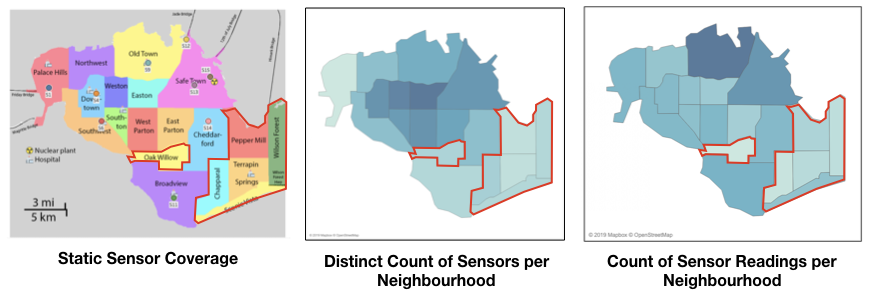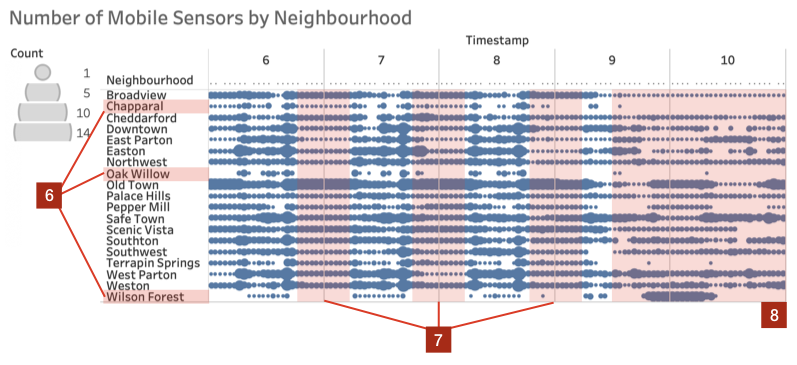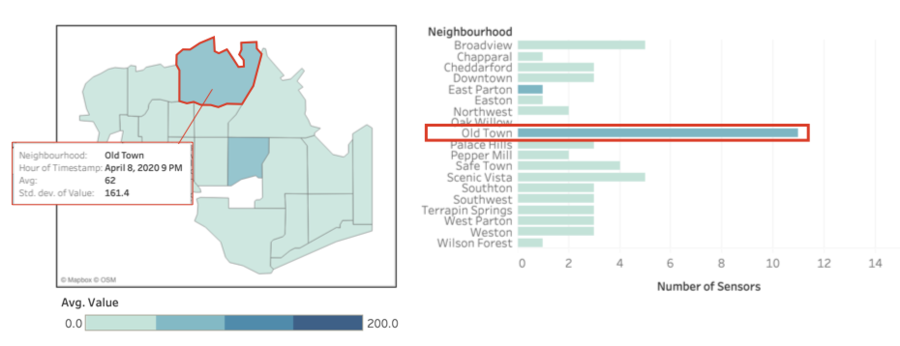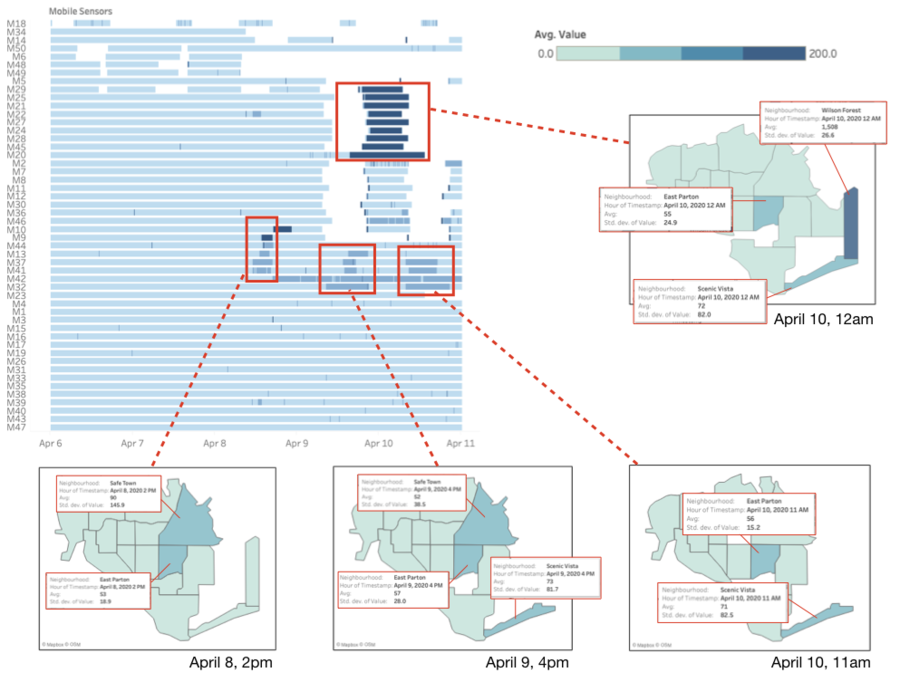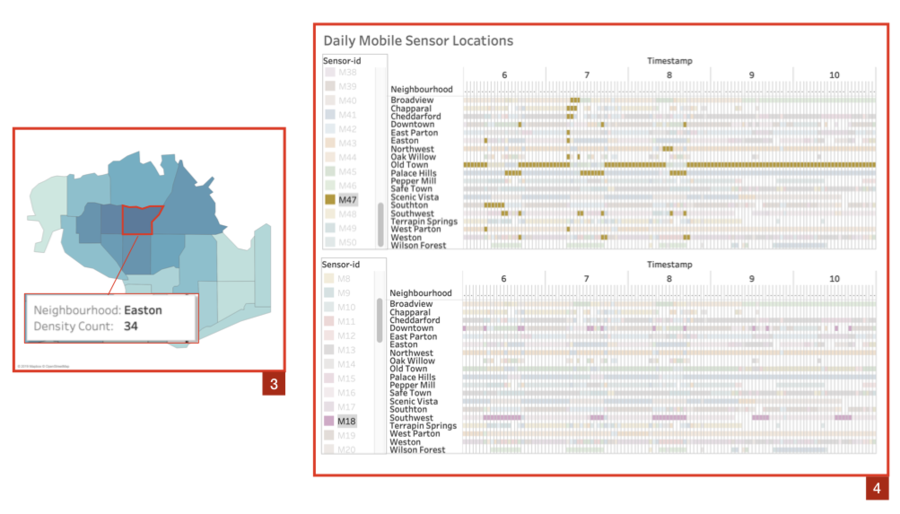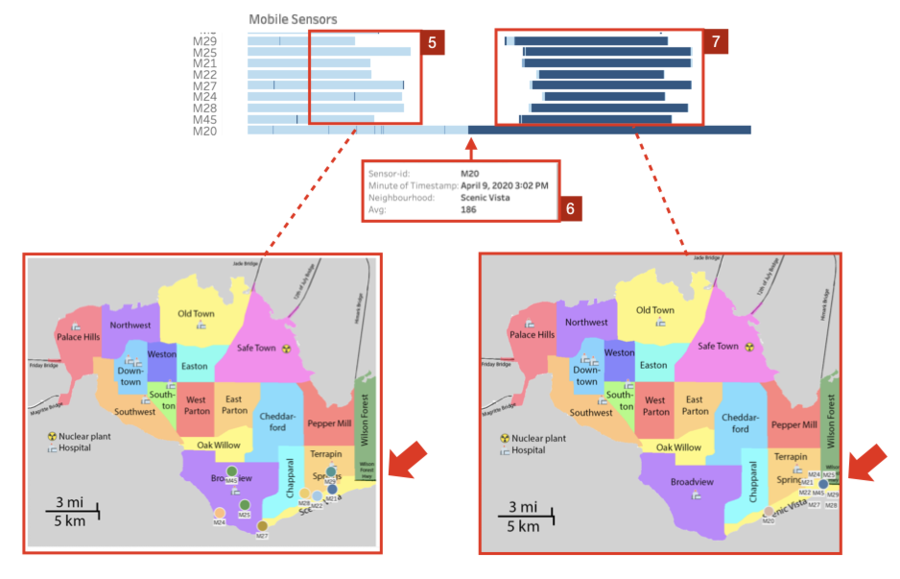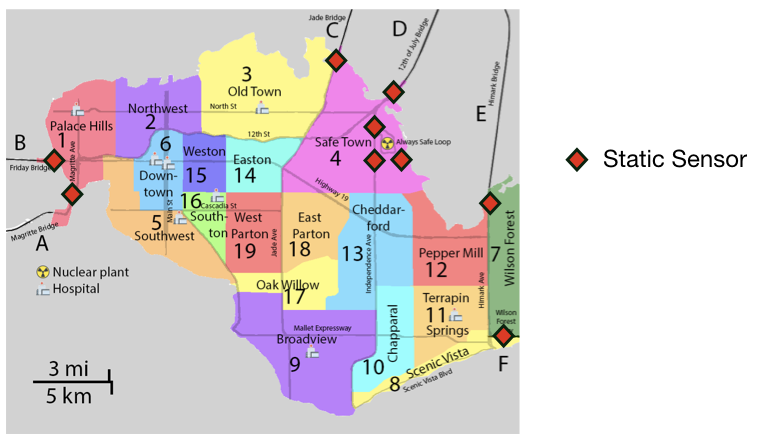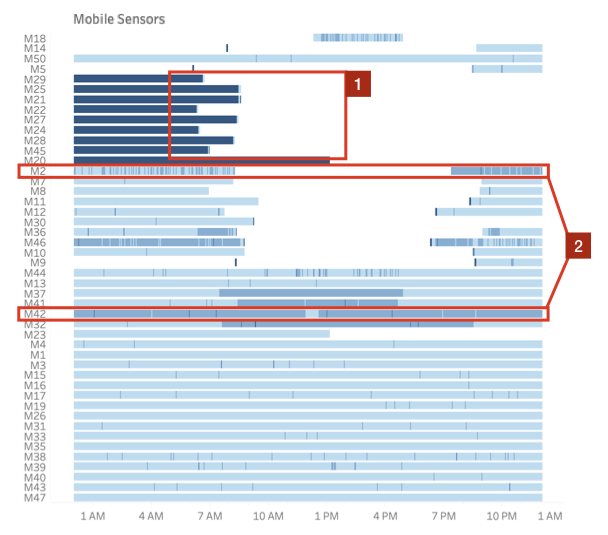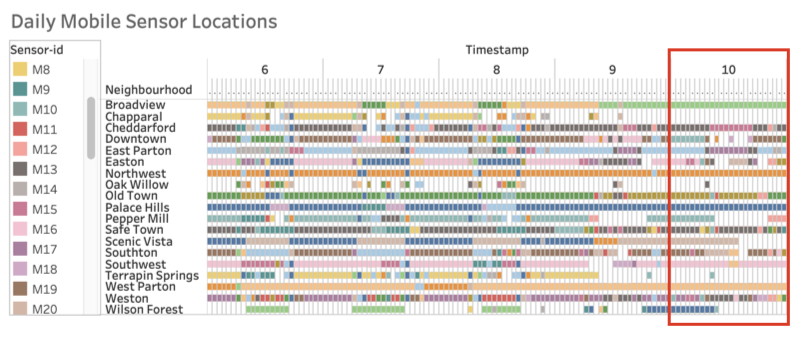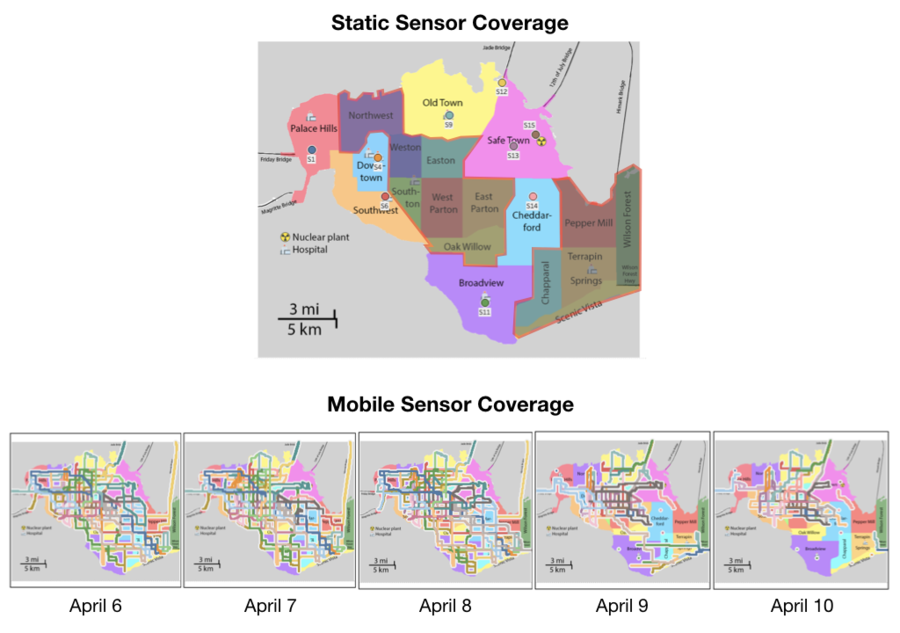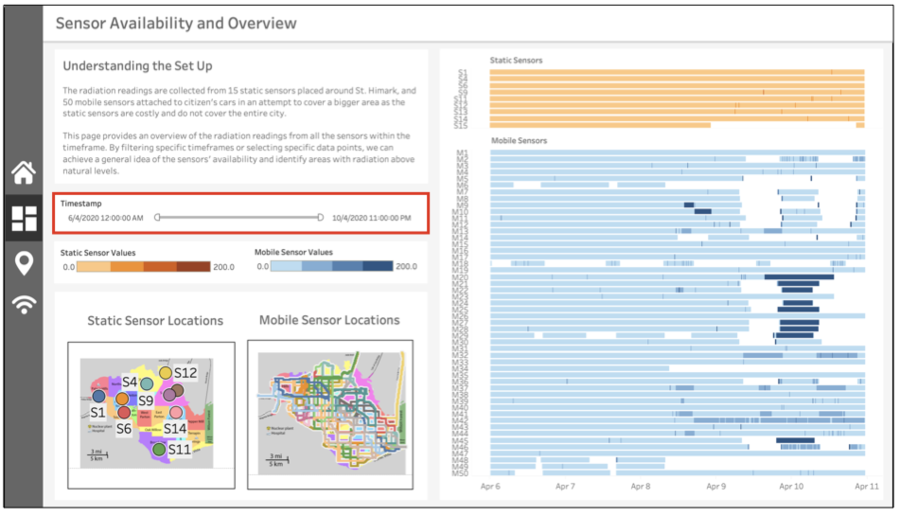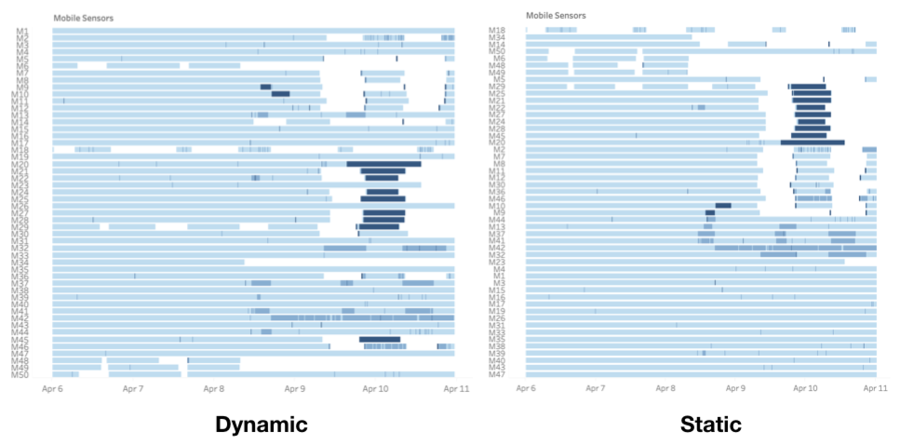IS428 AY2019-20T1 Assign Lim Pei Xuan: Task Answers
Your task, as supported by visual analytics that you apply, is to help St. Himark’s emergency management team combine data from the government-operated stationary monitors with data from citizen-operated mobile sensors to help them better understand conditions in the city and identify likely locations that will require further monitoring, cleanup, or even evacuation. Will data from citizen scientists clarify the situation or make it more uncertain? Use visual analytics to develop responses to the questions below.
Contents
- 1 Question 1
- 2 Question 2
- 2.1 Use visual analytics to represent and analyze uncertainty in the measurement of radiation across the city. Compare uncertainty of the static sensors to the mobile sensors. What anomalies can you see? Are there sensors that are too uncertain to trust?
- 2.2 Which regions of the city have greater uncertainty of radiation measurement? Use visual analytics to explain your rationale. What effects do you see in the sensor readings after the earthquake and other major events? What effect do these events have on uncertainty?
- 3 Question 3
- 3.1 Given the uncertainty you observed in question 2, are the radiation measurements reliable enough to locate areas of concern? Highlight potential locations of contamination, including the locations of contaminated cars. Should St. Himark officials be worried about contaminated cars moving around the city?
- 3.2 Estimate how many cars may have been contaminated when coolant leaked from the Always Safe plant. Use visual analysis of radiation measurements to determine if any have left the area.
- 3.3 Indicated where you would deploy more sensors to improve radiation monitoring in the city. Would you recommend more static sensors or more mobile sensors or both? Use your visualization of radiation measurement uncertainty to justify your recommendation.
- 4 Question 4
- 4.1 Summarize the state of radiation measurements at the end of the available period. Use your novel visualizations and analysis approaches to suggest a course of action for the city.
- 4.2 Use visual analytics to compare the static sensor network to the mobile sensor network. What are the strengths and weaknesses of each approach? How do they support each other?
- 5 Question 5
Question 1
Visualize radiation measurements over time from both static and mobile sensors to identify areas where radiation over background is detected. Characterize changes over time.
| No. | Description |
|---|---|
|
1 |
Static sensors do not seem to have detected many spikes in readings, with the majority of readings below 50 throughout the period. This is especially interesting as static sensors 13 and 15 are in very close proximity to the Always Safe Nuclear Plant, which means these two sensors should pick up a spike in readings if there is radiation leak. |
|
2 |
Prior to the morning of April 8, both mobile and static sensor readings largely maintained below 50 cpm. However, there were 2 clusters of sensor failure on April 6 and April 7. On the morning of April 8, 4 mobile sensors completely stopped transmitting radiation readings, and multiple instances of high mobile sensor radiation readings began thereafter. There may have been an earthquake on the morning of April 8 that led to some permanent sensor damage as well as radiation leak. |
|
3 |
During the day of April 9 and April 10, a substantial number of sensors stopped transmitting. |
| No. | Description |
|---|---|
|
4 |
9 of the mobile sensors consistently reported extremely high radiation readings throughout the night of April 10, immediately after they started transmitting data again. |
|
5 |
Filtering their locations on the map, we can see that they were stationary, clustered around the same neighbourhoods (Wilson Forest and Scenic Vista). |
| No. | Description |
|---|---|
|
6-8 |
Three other clusters of high readings across three days were identified from the mobile sensor data. The neighbourhoods the readings came from were identified as Safe Town, East Parton, and Scenic Vista. |
Question 2
Use visual analytics to represent and analyze uncertainty in the measurement of radiation across the city. Compare uncertainty of the static sensors to the mobile sensors. What anomalies can you see? Are there sensors that are too uncertain to trust?
| No. | Description |
|---|---|
|
1 |
Static sensor 15 is placed right outside of the Always Safe Nuclear Plant, and hence should be the first line of detection when there is a radiation leak. However, it did not transmit any radiation readings between 10pm on April 8 and 9pm on April 10, which was the main timeframe where the mobile sensors reported abnormal radiation readings. |
|
2 |
In general, the static sensor readings rarely spiked, and even if they did they spiked in relatively short bursts. If there is a radiation leak or signs of contamination in an area, radiation readings should spike for sustained period. This makes the reliability of the static sensors questionable as it is unrealistic to respond to every short term increase in radiation readings. |
| No. | Description |
|---|---|
|
3 |
Some sensors seem to have intermittent connectivity, resulting in no readings being transmitted. With faulty sensors, it can be hard to determine if the halt in radiation readings is due to an event like an earthquake. |
|
4 |
Another issue is the range of the sensors. When many cars leave St. Himark at once, the number of readings available for analysis drops significantly. With a decrease in mobile sensors in the city, it becomes harder to get a good spread of readings and results in uncertainty in regions with no static or mobile sensors. |
Which regions of the city have greater uncertainty of radiation measurement? Use visual analytics to explain your rationale. What effects do you see in the sensor readings after the earthquake and other major events? What effect do these events have on uncertainty?
| No. | Description |
|---|---|
|
5 |
Highlighted in red are neighbourhoods that are the most uncertain. Firstly, they do not have any static sensors, which represents a chance that there will be no readings if there are no mobile sensors present in the neighbourhood. In addition, these neighbourhoods are visited by a small number of cars, meaning that readings are dependent on these few cars. As a result, the total number of sensor readings coming from these neighbourhoods are low and could be easily thrown off by erroneous readings by faulty sensors. |
| No. | Description |
|---|---|
|
6 |
Readings originating Chapparal, Oak Willow, and Wilson Forest are sparse and there are often situations where there are no mobile sensors in those regions. This creates some difficulty in detecting potential contamination in those regions. |
|
7 |
Depending on the time of the day, as the residents go about their daily routine the distribution of sensors throughout the city changes. This is especially apparent overnight, as the majority of sensors are clustered at Old Town and Broadview. |
|
8 |
After the earthquake/major event, the distribution of sensors becomes even more erratic. There is a drop in the number of functioning sensors as well, which makes it harder than before to get reliable readings. |
Question 3
Given the uncertainty you observed in question 2, are the radiation measurements reliable enough to locate areas of concern? Highlight potential locations of contamination, including the locations of contaminated cars. Should St. Himark officials be worried about contaminated cars moving around the city?
| No. | Description |
|---|---|
|
1 |
In situations where multiple areas show signs of possible contamination and the city lacks resources to assess all of them given that the readings might be inaccurate, a decision can be made based on the number of sensors in the region. If a particular region has a large number of sensors with high average ratings, it is more likely that it is indeed a contaminated area. However, caution has to be taken as just 1 rogue sensor with extremely high readings can bring up the overall average. Hence, a decision has to be made after carefully comparing the standard deviation and number of sensors. |
| No. | Description |
|---|---|
|
2 |
Possibly contaminated areas throughout the simulation are East Parton, Safe Town, East Parton, and Scenic Vista. |
| No. | Description |
|---|---|
|
3 |
The number of cars travelling through each region plays a part in analysing possible contaminations. For example, 34 out of the 50 cars passed by Easton during the simulation, meaning that Easton is frequently visited by the majority of St.Himark’s residents. Should there be a radioactive leak or contaminant in Easton, there is a high chance that it might contaminate all the other cars that pass by and spread to the other regions. |
|
4 |
Another concern is the routine of each individual car. Some cars pass through a large number of regions daily, and some stay within 1 or 2 regions. If an extremely mobile car gets contaminated and goes about its daily routine, it may spread the contaminant to the all regions it visits. |
Estimate how many cars may have been contaminated when coolant leaked from the Always Safe plant. Use visual analysis of radiation measurements to determine if any have left the area.
| No. | Description |
|---|---|
|
5 |
These 9 cars were parked at the southern side of the island overnight, and gradually left the island via Wilson Forest Highway during the day on April 9. |
|
6 |
Mobile sensor 20 remained stationary throughout the day, inside Scenic Vista. Radiation readings were normal until about 3pm on April 9, when readings began to spike. This could be when the coolant leak happened. |
|
7 |
The cars that left via Wilson Forest Highway returned that night with normal radiation readings upon entering. However, they quickly began reporting extremely high radiation readings as well, and remained at Wilson forest overnight before leaving St.Himark again on the morning of April 10. If those cars got contaminated from spending the night at Wilson Forest, the authorities should be very concerned as the contamination could be spread to other cities that are connected to St.Himark. |
Indicated where you would deploy more sensors to improve radiation monitoring in the city. Would you recommend more static sensors or more mobile sensors or both? Use your visualization of radiation measurement uncertainty to justify your recommendation.
| No. | Description |
|---|---|
|
8 |
Static Sensor 15 was supposed to be the first hand indication of radiation leaks, given its position right outside the nuclear plant. However, it’s premature failure during the simulation resulted in the lack of an immediate indicator. The static sensors’ short range also limited its usefulness in analysis of contamination and its spread. As the static sensors are costly, I would recommend repositioning the 9 existing sensors. To facilitate detection of radiation leaks, 3 static sensors should be placed in the vicinity of the always safe loop. This way, we will still have data if one or two of the sensors become damaged. The remaining 6 sensors should be placed at the start of each of the 6 bridges that connect St.Himark. This will help detect any form of contamination that is being carried to and from the city, and help authorities contain the contamination. |
|
9 |
As the mobile sensors are relatively cheaper, radiation monitoring within the city could be improved with the deployment of even more mobile sensors. With more mobile sensors there will be lower uncertainty in measurements and higher coverage, making for more meaningful analysis of the situation within the city. If increasing the number of mobile sensors is not possible, they should aim to even out the distribution of the mobile sensors, by selecting cars with different travel patterns. |
Question 4
Summarize the state of radiation measurements at the end of the available period. Use your novel visualizations and analysis approaches to suggest a course of action for the city.
| No. | Description |
|---|---|
|
1 |
The 8 contaminated cars left St.Himark and have not returned since. To prevent further contamination, the city should attempt to locate the cars as soon as possible. |
|
2 |
Sensors M2 and M42 are still transmitting high radiation readings, and have been doing so for some time. This could be indicative of a contaminated area/car and should be looked into as well. |
| No. | Description |
|---|---|
|
3 |
The number of cars going through Chapparal and Terrapin Springs suddenly decreased towards the end of the simulation. There could be infrastructural damage or other reasons leading to this decrease. |
Use visual analytics to compare the static sensor network to the mobile sensor network. What are the strengths and weaknesses of each approach? How do they support each other?
| No. | Description |
|---|---|
|
4 |
The 9 static sensors are only cover 7 out of the 19 neighbourhoods, leaving many neighbourhoods in Central and Southeast St.Himark uncovered. The range of the static sensors also do not seem to be sufficient to detect radiation over an entire neighbourhood given their relatively low readings, with the occasional spike. |
|
5 |
The mobile sensors provided much better coverage of the city, with the 50 sensors covering pretty much the entire island on a day to day basis. However, in the aftermath of an earthquake or major event (April 9 – 10) the mobility of cars can become restricted due to infrastructure damage. Citizens may also avoid travelling in the aftermath, resulting in lesser ground covered. |
Question 5
The data for this challenge can be analyzed either as a static collection or as a dynamic stream of data, as it would occur in a real emergency. Describe how you analyzed the data - as a static collection or a stream.
| No. | Description |
|---|---|
|
1 |
In the process of designing the dashboard, I ensured that all the visualizations could be filtered by date. This is so that static analysis can be done on the entire dataset, as well as dynamic analysis by working on a sliding window of data. |
How do you think this choice affected your analysis?
| No. | Description |
|---|---|
|
2 |
While most of the analysis could be done dynamically, static analysis is especially helpful when trying to identify clusters or patterns in the data. When viewing a stream of dynamic sensor data, it is very difficult to immediately identify patterns or gaps at a glance. However, when viewed statically, it is possible to sort them in a manner where visible clusters and patterns can be found to make meaningful analysis. |






